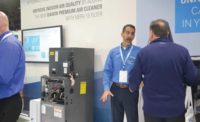As spring turns into summer and warm weather blankets the U.S., many homeowners are turning on their air conditioners for the first time only to find they do not work.
Faced with potentially lofty repair bills, homeowners must decide whether to repair or replace their condensing units, which is not an easy decision.
HVAC contractors are the go-to experts on the subject, and despite their expertise, there a number of factors they must consider before making recommendations to homeowners.
“The type of a repair is a factor,” said Rich Biava, vice president, GAC Services, Gaithersburg, Maryland. “There’s a big difference between replacing a contactor or capacitor versus a reversing valve or compressor. We also look at whether the unit utilizes R-22 or R-410A, the time of year, how long a repair would help the customer this year, and the age and condition of the system. If the system is very old and not in good shape, we may opt to replace it; if it’s newer and just needs a part, we may consider making the repair. Lastly, we consider the homeowner’s needs. Do they have disposable income or are they searching for their last dollar? I think these elements are all part of the decision making that occurs when offering a replacement.”
Paul Sammataro, owner of Samm’s Heating and Air Conditioning in Plano, Texas, said age, repair history, and the cost of the repair usually determine when his technicians recommend replacement over repair.
Steve Wade, general manager, ARS/RescueRooter, Itasca, Illinois, said the criteria his technicians use when recommending a replacement are also age, condition, and type of refrigerant versus the cost of repair.
“A good barometer is the $5,000 rule, which is used by multiplying the age of the unit by the cost of the repair,” he said. “If the sum is equal to or greater than $5,000, it’s normally appropriate to consider a replacement. For example, if an 11-year-old condensing unit needs a $600 repair, we would suggest our customer consider a replacement. Do the math. Eleven times $600 equals $6,600, which is greater than $5,000.”
REPLACING THE SYSTEM
While replacement of just the condensing unit is possible, many contractors recommend replacing the entire system rather than one component.
“We don’t suggest replacing just the outdoor unit,” Biava said. “We typically sell the outdoor unit and the coil together, so the indoor coil is replaced at the same time as that outdoor unit. There may be a handful of times in the year where the furnace and coil have already been replaced a few years ago and all we’re doing is replacing the outdoor unit, but that’s not very often.”
GAC encourages its customers to purchase this option over replacing just the condensing unit or coil by themselves.
“We put a warranty on these systems,” Biava explained. “The outdoor unit and the coil work together to provide comfort, efficiency, and reliability. So, we prefer to replace both at the same time. Sometimes we get customers who prefer to replace only the coil because they don’t have the money to replace both. And then, a few months later, the compressor goes and they’re upset. We talk to customers about these conditions and what could happen if we just piecemeal the system together. That’s something we don’t want to do, we don’t like to just put a Band-Aid on something.”
According to Biava, 65 percent of GAC’s replacement business is both heating and cooling systems. “It’s a little more money than to just replace the outdoor unit, but you get a happier, long-term customer that way. In the end, that’s what we want.”
Sammataro said there are times when a recently replaced indoor coil matches up with a new condenser when the proper thermostatic expansion valve (TXV) is added, and there are times when the indoor coil is too old and not meeting the correct matchup requirement to achieve the properly designed rating of the outdoor unit.
At that point, his team recommends that the indoor coil and condenser are replaced.
“We ask questions to determine the best recommendation for each customer based on the diagnosis at that time,” Sammataro said. “Customers usually opt for repairs when the repairs are minor, they’re not staying in the home much longer, or a replacement is not financially feasible.”
Wade said replacing only the condensing unit seldomly happens.
“Although it can be done, it has become increasingly rare to replace only the condensing unit with age, condition, refrigerant, and efficiency playing major roles in this decision,” he said. “The high cost of R-22 refrigerant, the likelihood of additional repairs, and the reduction in rated efficiency without a correctly matched evaporator coil can make this a short-sighted decision.”
After diagnosing and identifying the problem, trained technicians present customers with options to meet their needs, Wade noted.
“The options may include the minimum repair to get the unit running, additional repairs to return the unit to factory standards, or replacement of the unit with one of similar or greater efficiency. The costs of the repairs and their warranties are written to be easily understood. Another option is to receive the price for a new unit, which may improve performance, efficiency, and include a longer manufacturer warranty. Our technicians provide a detailed explanation of all available options and ultimately let customers select the option that best suits their needs.
“Many times our customers opt for repair, especially on commonly replaced, less-costly components, like contactors and capacitors,” he continued. “The higher cost repairs, like replacing a condenser fan motor or compressor, give us a stronger consideration to recommend a system replacement.”
A CHANGING ECONOMY
Biava noted that homeowners are getting more estimates from different companies than they did during the Great Recession.
“Back in 2004-2005, when people felt really good about the economy, they were getting two, maybe three estimates. Once the recession hit around 2009, customers were requesting more estimates. Our sales guys are still telling us they’re often the fifth or sixth estimate on a job.”
“When the economy is bad, people tend to be less proactive when it comes to replacements,” Sammataro added. “They tend to act with an as-needed replacement mind-set.”
Wade said he has seen a noticeable increase in the replacement of systems today compared to those in recent years.
“There seems to have been an increase in consumer spending and confidence lately, and many systems installed during the housing boom received little-to-no maintenance during the recession,” he said. “Consumers are also more aware and interested in the benefits of higher efficiency furnaces and air conditioners, app-driven systems, and those that complement today’s connected homes. These factors, as well as the changing economy, have helped our customers choose replacement over costly repairs more frequently.”
Publication date: 6/12/2017
Want more HVAC industry news and information? Join The NEWS on Facebook, Twitter, and LinkedIn today!











